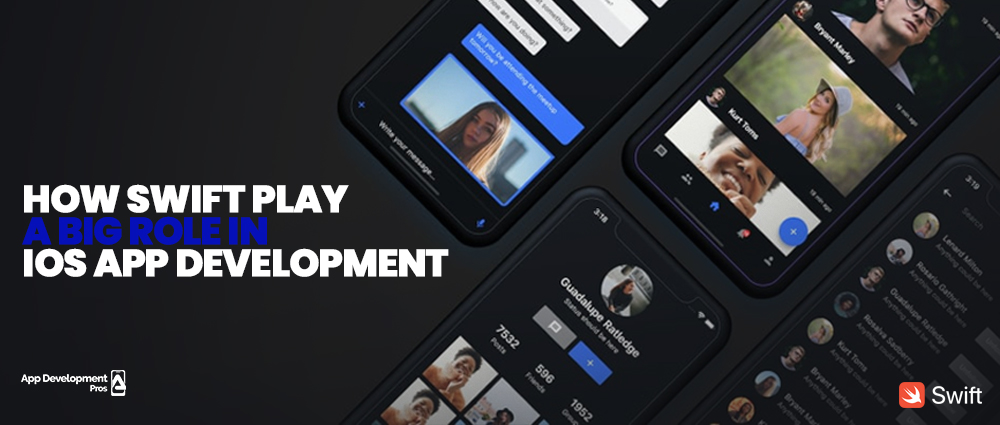How Swift Play a Big Role in IOS App Development?

April 14 , 2020 Posted by Admin
In today’s development environment, the first programming language that comes into mind is Swift, which is relatively newer than others but holds full maturity in IOS app development. Many companies, when deciding to come over to the mobile platform, choose IOS due to its popularity and the benefits it offers. When choosing the programming language for iOS app development, companies and even programmers face certain challenges. Choosing the right language that perfectly fits the iOS environment plays a prominent role in deciding the fate of the project’s success.
Swift was released on 2 June 2014 by Apple and was made open-source due to its instant acceptance and high admiration. Developing an IOS app is not an easy task and requires proper research about the platform, tools, and language. If you are looking for an iOS app development tutorial swift, you are at the right place. Let’s have a look at how Swift is playing a big role in the IOS app development.
Easier To Maintain

Objective-C was unable to cope with the ever-changing demands of the IOS platform. Objective-C can’t evolve without the evolution in C language; that’s the reason that is holding it back from evolving. C language requires maintaining two files to create the executable app, which is the case with Objective-C.
On the other hand, it’s custom mobile app development dropped the trend of the two-file requirement to build an IOS app. Within the code, the LLVM compiler and XCode can perform incremental builds automatically by identifying dependencies. iOS app development on Windows can combine the header directly and implementation files into a single .swift file instead of separating the header file from the implementation file.
Safer Than Other Languages

For IOS apps, safety must be the priority, especially crucial for app-based startups. A Swift tutorial would be an added benefit if the app is easier to maintain. Thus, Swift offers high maintenance while Objective-C lacks it.
The entire code block becomes non-functional if you call a method with a null pointer variable returning nothing. IOS Application-building services seem quite beneficial due to their app crash prevention. However, it is considered a bad coding practice as it opens the doors for hundreds of bugs. While in Swift, a compile-time error is generated when a null pointer variable is found. It eliminates the possibility of bad code, ensuring that programmers write code compulsorily helping them to fix issues right away with easier bug identification and fixing processes.
Unified In Memory Management

The Automatic Reference Counting (ARC) inside Objective-C supports Cocoa Touch APIs and object-oriented code, eliminating the use of procedural C code & APIs.
Swift provides complete support, whether the code is object-oriented or procedural, making the coding process easier for the developers. In Objective-C, when working with procedural code, low-level APIs, and Core Graphics APIs, it’s the responsibility of programmers to handle memory management. However, Swift handles all memory management tasks at compile time using ARC. It saves time as well as the brainpower of developers required in the creation of the IOS app’s logic.
Supports Dynamic Libraries

Dynamic libraries are the executable blocks of codes that can be linked with an IOS app. In other words, Dynamic libraries are considered external files of the IOS app. However, these are included inside the app bundle downloaded from the Apple App Store. Before the launch of Swift programming language, IOS didn’t support dynamic libraries, though they were available on Mac. With Swift, it is not possible to add dynamic libraries with the IOS app. Swift apps can now be linked with the latest version of Swift language, reducing the size of the app. Swift apps aren’t heavy at all, as external codes are only lined when they are used by iPad app development companies.
Conclusion
Swift language has much to offer and requires exploration before using it to the maximum potential. This language is fun and exciting to learn Swift and offers some great functionality that isn’t available in most languages that brings the best out of it. In Swift, less time is spent on bookkeeping, so more time is available for creating app logic. It has a high ability to handle tasks that previously weren’t monitored by any language, which has made it a preferred iOS app development language.
Also Read: 4 Best Online Courses for iOS Developers
Services

We at App Development Pros, a renowned mobile app development company, are like superheroes of the smartphone app world! We provide digital opportunities in the mobile app design form and help you turn fantastic ideas into powerful mobile apps for your business needs. Our top-notch app development services build the perfect mobile applications for your needs by working closely with you, making us one of the USA's best mobile app development companies.
2025 (c) App Development Pros - Privacy Policy - All Rights Reserved



































Leave a Reply